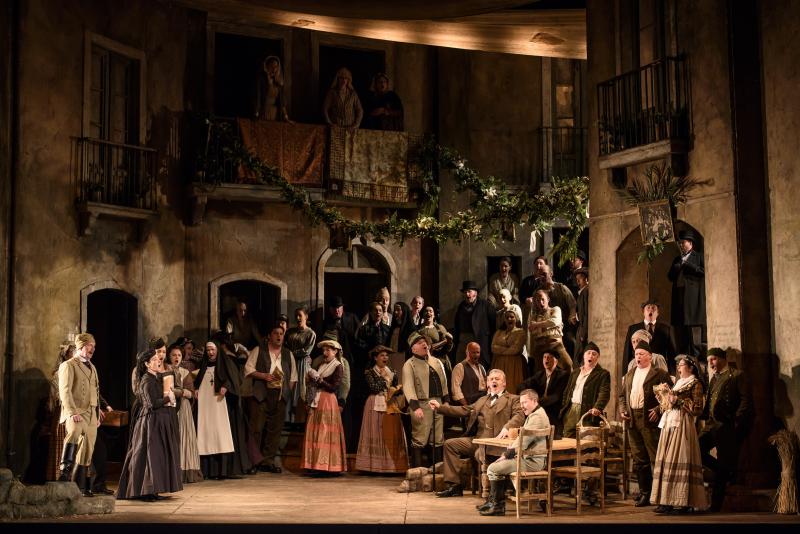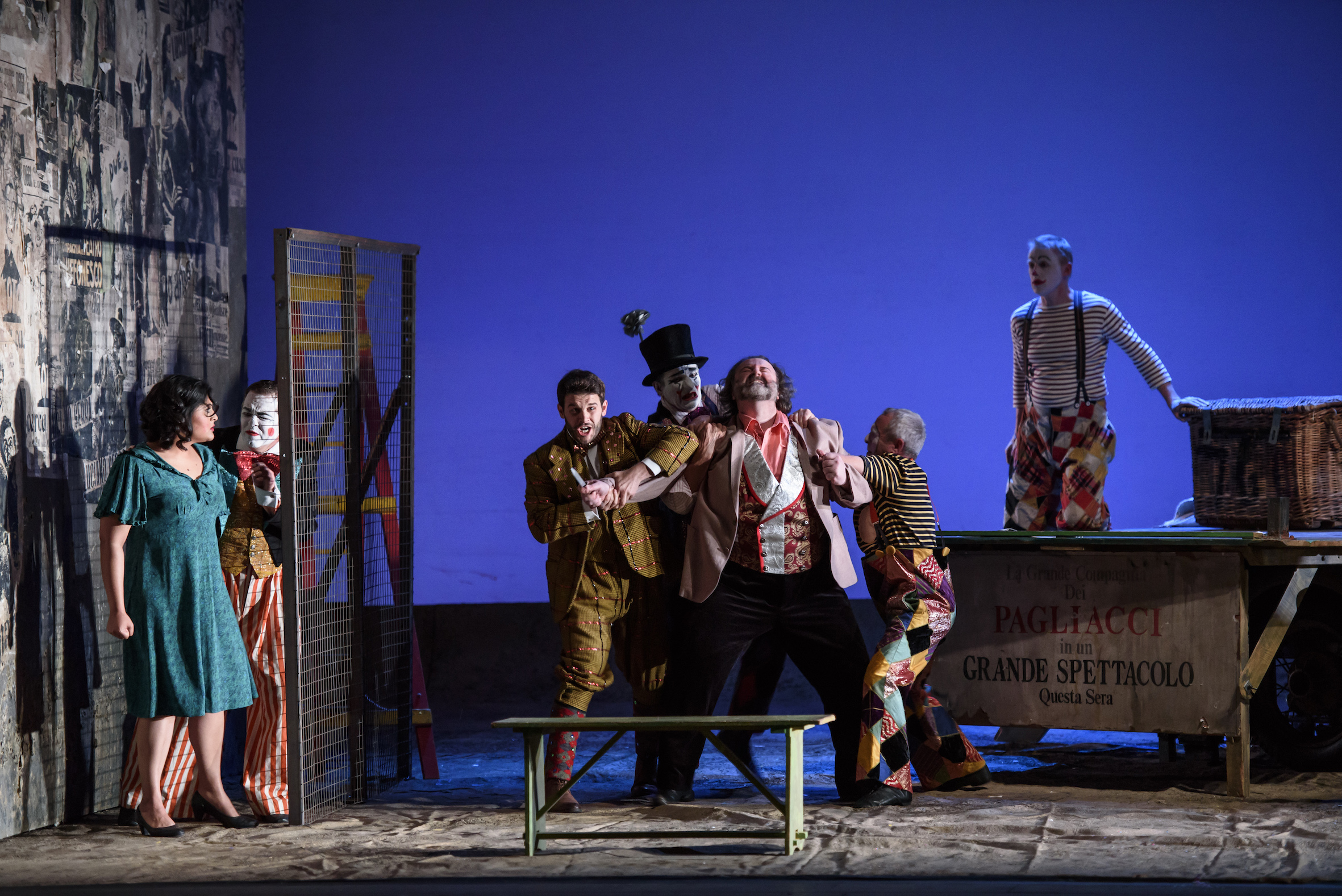Cavalleria Rusticana, Pagliacci, Welsh National Opera | reviews, news & interviews
Cavalleria Rusticana, Pagliacci, Welsh National Opera
Cavalleria Rusticana, Pagliacci, Welsh National Opera
Double bill celebrates Italy in Wales and 70 years of changing styles

Seventy years ago, almost to the month, Welsh National Opera took to the stage for the first time with a double bill of the terrible twins, Cavalleria rusticana and Pagliacci; and fifty years later the company celebrated with the same two works directed by Elijah Moshinsky, designed by Michael Yeargan. To repeat the exercise in the same productions after another twenty years might seem an egregious piece of navel-gazing.
Moshinsky’s idea, simple enough in all conscience, was to locate Mascagni’s rustic chivalry in a stage Sicily of the purest Forties cardboard, but to do it so observantly and with such fresh intensity that the old-fashioned shone with a new light. The Potemkin sets, the chest-beatings and hair-tearings, the “realism” of choruses that, in Wagner’s memorable phrase, are “scenery that has learnt to march and sing,” the absence of anything that could remotely be called a “concept” – all these energised, rather than ossifying, a work that has survived because of them, not in spite of them.
It still needs the best singers, however well fedLeoncavallo’s little masterpiece, which certainly does have a concept (we get it in Tonio’s homily before the curtain, though even this takes on a certain ironic focus in the light of his behaviour later on), was acted out on an empty stage, with a highly mobile choreography, a battered lorry for the commedia, “modern” – at least not 1890s – costume, and a Calabria that could be anywhere on the map.
Of course, Pagliacci isn’t exactly The Ring, though the score borrows from it often enough; isn’t intellectually open-ended, isn’t exactly intellectual at all. It still needs the best singers, however well fed, with a certain skill in making overacting look right, and these days WNO can supply these things in a way that I suspect they couldn’t have done in their amateur days of the forties and fifties.
In fact, this revival (by Sarah Crisp) shows that strong casting can even make Cavalleria rusticana act out like at least minor Verdi. When I first saw the piece at Sadler’s Wells in 1963, with the monumental (in every sense) Rita Hunter as Santuzza, I admired the voice but hated the character, with her endless, pointless moaning about her obviously worthless ex-lover.
Camilla Roberts draws one into the character in quite a different way, with a warm presence and richly coloured tone – the best singing I’ve heard from this stylish performer. Gwyn Hughes Jones is a brilliant, uninhibited Turiddu, convincing in his shameless self-justifications, but even momentarily touching in his acceptance of Alfio’s (David Kempster’s) accusations. In fact the whole performance, with excellent support from Anne-Marie Owens (Santuzza in 1996, here Mamma Lucia) and Rebecca Afonwy-Jones (Lola), proves unusually coherent for a work normally regarded as the inferior partner in the bill.
 Pagliacci gets a somewhat lighter touch. I at first had the feeling that Hughes Jones (pictured above trying to knife Meeta Raval) was holding back as Canio; it’s a tough doubling, after all. But the distinction in colour, the slight thinning of tone, was surely deliberate – different place, time, personality. And there was no compression in “Vesti la giubba” or in the transformation from grease-paint to blood-lust in the commedia. Kempster, a fine, elderly-looking Alfio in Cav, limps around malevolently as Tonio, his leg in a brace, other parts of the anatomy evidently fully operational. But Moshinsky imposes no sex as such, as his 2016 equivalent would surely do. Meeta Raval, a lively-voiced Nedda, gets her leg stroked, and that’s about it. How very 1990s! Gyula Nagy is a vigorous, personable Silvio, Trystan Llŷr Griffiths a smart, noticeable Beppe.
Pagliacci gets a somewhat lighter touch. I at first had the feeling that Hughes Jones (pictured above trying to knife Meeta Raval) was holding back as Canio; it’s a tough doubling, after all. But the distinction in colour, the slight thinning of tone, was surely deliberate – different place, time, personality. And there was no compression in “Vesti la giubba” or in the transformation from grease-paint to blood-lust in the commedia. Kempster, a fine, elderly-looking Alfio in Cav, limps around malevolently as Tonio, his leg in a brace, other parts of the anatomy evidently fully operational. But Moshinsky imposes no sex as such, as his 2016 equivalent would surely do. Meeta Raval, a lively-voiced Nedda, gets her leg stroked, and that’s about it. How very 1990s! Gyula Nagy is a vigorous, personable Silvio, Trystan Llŷr Griffiths a smart, noticeable Beppe.
Both these operas are big on chorus, which is no doubt why they were chosen in 1946, and is certainly why they still do well on this much bigger stage. Whether standing and delivering in Cav or rushing around eagerly in Pag, the WNO chorus is top drawer, genuinely the best. The orchestra too. Carlo Rizzi conducts, as one would expect, with a fine feeling for the pace and varied density of these two quintessentially Italian works, now, like him, Welsh by adoption.
Add comment
The future of Arts Journalism
You can stop theartsdesk.com closing!
We urgently need financing to survive. Our fundraising drive has thus far raised £49,000 but we need to reach £100,000 or we will be forced to close. Please contribute here: https://gofund.me/c3f6033d
And if you can forward this information to anyone who might assist, we’d be grateful.

Subscribe to theartsdesk.com
Thank you for continuing to read our work on theartsdesk.com. For unlimited access to every article in its entirety, including our archive of more than 15,000 pieces, we're asking for £5 per month or £40 per year. We feel it's a very good deal, and hope you do too.
To take a subscription now simply click here.
And if you're looking for that extra gift for a friend or family member, why not treat them to a theartsdesk.com gift subscription?
more Opera
 La bohème, Opera North review - still young at 32
Love and separation, ecstasy and heartbreak, in masterfully updated Puccini
La bohème, Opera North review - still young at 32
Love and separation, ecstasy and heartbreak, in masterfully updated Puccini
 Albert Herring, English National Opera review - a great comedy with depths fully realised
Britten’s delight was never made for the Coliseum, but it works on its first outing there
Albert Herring, English National Opera review - a great comedy with depths fully realised
Britten’s delight was never made for the Coliseum, but it works on its first outing there
 Carmen, English National Opera review - not quite dangerous
Hopes for Niamh O’Sullivan only partly fulfilled, though much good singing throughout
Carmen, English National Opera review - not quite dangerous
Hopes for Niamh O’Sullivan only partly fulfilled, though much good singing throughout
 Giustino, Linbury Theatre review - a stylish account of a slight opera
Gods, mortals and monsters do battle in Handel's charming drama
Giustino, Linbury Theatre review - a stylish account of a slight opera
Gods, mortals and monsters do battle in Handel's charming drama
 Susanna, Opera North review - hybrid staging of a Handel oratorio
Dance and signing complement outstanding singing in a story of virtue rewarded
Susanna, Opera North review - hybrid staging of a Handel oratorio
Dance and signing complement outstanding singing in a story of virtue rewarded
 Ariodante, Opéra Garnier, Paris review - a blast of Baroque beauty
A near-perfect night at the opera
Ariodante, Opéra Garnier, Paris review - a blast of Baroque beauty
A near-perfect night at the opera
 Cinderella/La Cenerentola, English National Opera review - the truth behind the tinsel
Appealing performances cut through hyperactive stagecraft
Cinderella/La Cenerentola, English National Opera review - the truth behind the tinsel
Appealing performances cut through hyperactive stagecraft
 Tosca, Royal Opera review - Ailyn Pérez steps in as the most vivid of divas
Jakub Hrůša’s multicoloured Puccini last night found a soprano to match
Tosca, Royal Opera review - Ailyn Pérez steps in as the most vivid of divas
Jakub Hrůša’s multicoloured Puccini last night found a soprano to match
 Tosca, Welsh National Opera review - a great company reduced to brilliance
The old warhorse made special by the basics
Tosca, Welsh National Opera review - a great company reduced to brilliance
The old warhorse made special by the basics
 BBC Proms: The Marriage of Figaro, Glyndebourne Festival review - merriment and menace
Strong Proms transfer for a robust and affecting show
BBC Proms: The Marriage of Figaro, Glyndebourne Festival review - merriment and menace
Strong Proms transfer for a robust and affecting show
 BBC Proms: Suor Angelica, LSO, Pappano review - earthly passion, heavenly grief
A Sister to remember blesses Puccini's convent tragedy
BBC Proms: Suor Angelica, LSO, Pappano review - earthly passion, heavenly grief
A Sister to remember blesses Puccini's convent tragedy
 Orpheus and Eurydice, Opera Queensland/SCO, Edinburgh International Festival 2025 review - dazzling, but distracting
Eye-popping acrobatics don’t always assist in Gluck’s quest for operatic truth
Orpheus and Eurydice, Opera Queensland/SCO, Edinburgh International Festival 2025 review - dazzling, but distracting
Eye-popping acrobatics don’t always assist in Gluck’s quest for operatic truth

Comments
I saw the double bill in
I saw the double bill in Birmingham last night. Surely the Pagliacci (despite the abstraction of the white backdrop) is quite precisely set in the early postwar years - there are peeling posters for the neorealist film classic Bitter Rice (1949) on the side walls. I've always thought that the brilliance of the double bill was that it contrasts a social tragedy with a personal one, and so it makes perfect sense to keep Cavalleria in period; meanwhile, the early postwar years, with their uncertainty and deracination, are a perfect place to situate Pagliacci. Opera Holland Park did something similar in 2013; Cav was set in the socially oppressive Mussolini era, while Pag took place in the more liberal, but uneasy 1970s.